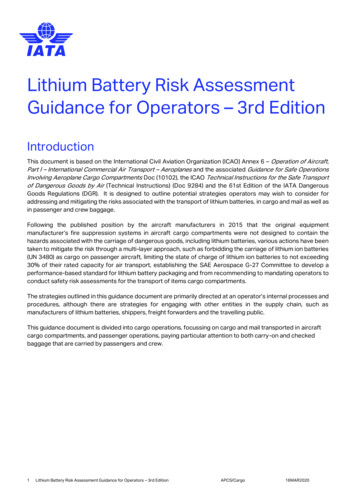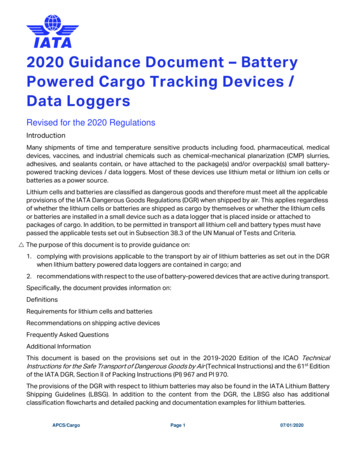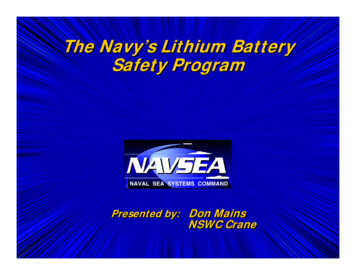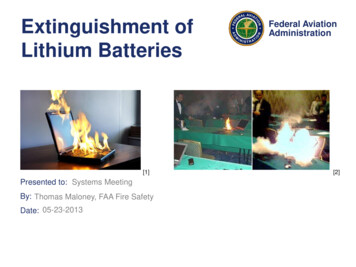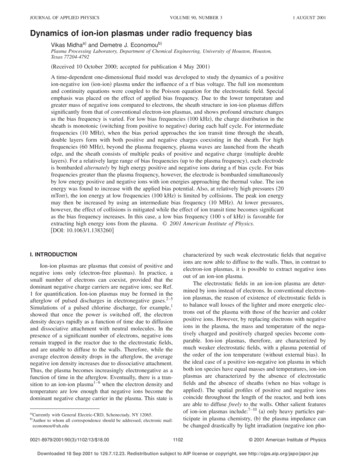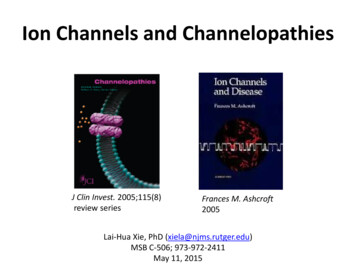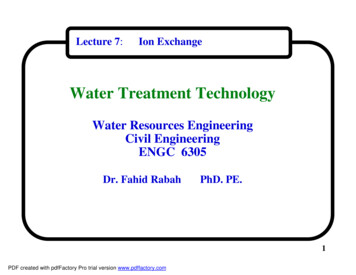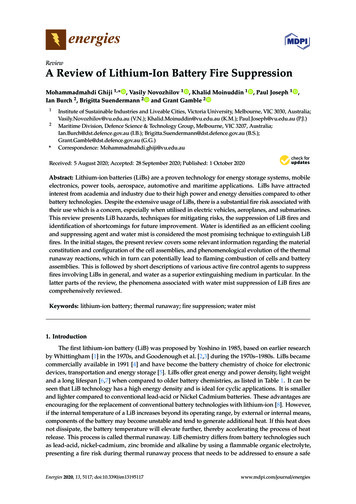
Transcription
energiesReviewA Review of Lithium-Ion Battery Fire SuppressionMohammadmahdi Ghiji 1, * , Vasily Novozhilov 1 , Khalid Moinuddin 1 , Paul Joseph 1 ,Ian Burch 2 , Brigitta Suendermann 2 and Grant Gamble 212*Institute of Sustainable Industries and Liveable Cities, Victoria University, Melbourne, VIC 3030, Australia;Vasily.Novozhilov@vu.edu.au (V.N.); Khalid.Moinuddin@vu.edu.au (K.M.); Paul.Joseph@vu.edu.au (P.J.)Maritime Division, Defence Science & Technology Group, Melbourne, VIC 3207, Australia;Ian.Burch@dst.defence.gov.au (I.B.); Brigitta.Suendermann@dst.defence.gov.au (B.S.);Grant.Gamble@dst.defence.gov.au (G.G.)Correspondence: Mohammadmahdi.ghiji@vu.edu.auReceived: 5 August 2020; Accepted: 28 September 2020; Published: 1 October 2020 Abstract: Lithium-ion batteries (LiBs) are a proven technology for energy storage systems, mobileelectronics, power tools, aerospace, automotive and maritime applications. LiBs have attractedinterest from academia and industry due to their high power and energy densities compared to otherbattery technologies. Despite the extensive usage of LiBs, there is a substantial fire risk associated withtheir use which is a concern, especially when utilised in electric vehicles, aeroplanes, and submarines.This review presents LiB hazards, techniques for mitigating risks, the suppression of LiB fires andidentification of shortcomings for future improvement. Water is identified as an efficient coolingand suppressing agent and water mist is considered the most promising technique to extinguish LiBfires. In the initial stages, the present review covers some relevant information regarding the materialconstitution and configuration of the cell assemblies, and phenomenological evolution of the thermalrunaway reactions, which in turn can potentially lead to flaming combustion of cells and batteryassemblies. This is followed by short descriptions of various active fire control agents to suppressfires involving LiBs in general, and water as a superior extinguishing medium in particular. In thelatter parts of the review, the phenomena associated with water mist suppression of LiB fires arecomprehensively reviewed.Keywords: lithium-ion battery; thermal runaway; fire suppression; water mist1. IntroductionThe first lithium-ion battery (LiB) was proposed by Yoshino in 1985, based on earlier researchby Whittingham [1] in the 1970s, and Goodenough et al. [2,3] during the 1970s–1980s. LiBs becamecommercially available in 1991 [4] and have become the battery chemistry of choice for electronicdevices, transportation and energy storage [5]. LiBs offer great energy and power density, light weightand a long lifespan [6,7] when compared to older battery chemistries, as listed in Table 1. It can beseen that LiB technology has a high energy density and is ideal for cyclic applications. It is smallerand lighter compared to conventional lead-acid or Nickel Cadmium batteries. These advantages areencouraging for the replacement of conventional battery technologies with lithium-ion [8]. However,if the internal temperature of a LiB increases beyond its operating range, by external or internal means,components of the battery may become unstable and tend to generate additional heat. If this heat doesnot dissipate, the battery temperature will elevate further, thereby accelerating the process of heatrelease. This process is called thermal runaway. LiB chemistry differs from battery technologies suchas lead-acid, nickel-cadmium, zinc bromide and alkaline by using a flammable organic electrolyte,presenting a fire risk during thermal runaway process that needs to be addressed to ensure a safeEnergies 2020, 13, 5117; s
Energies 2020, 13, 51172 of 30operating environment. Although fire can be extinguished by many methods, the effects of thermalrunaway are more difficult to manage and continued cooling is required.Table 1. Characteristics of different battery technologies [9]. Response time is the time to delivermaximum power output over a specific time, with h hours; min minutes; ms milliseconds;s seconds; NA not attery(500–6000)Lead-acid3–15 (2000)batteryAdvancedlead-acid3–15 (3000)batteryNickel-cadmium 00)batteryVanadium10–20redox flow(13–103)batteryPowerDensityWkg 1(kWm 3 nsityWhkg 1(kWhm 3 geDischarge Recharge (V)( C)min–hmin–h20 ms–s 10 to 500.1–0.3330–50 (75)min–h8–16 h5–10 ms 10 to 400.1–0.31.7575–300(90–700)30–50 (75)min–h8–16 h5 ms 10 to 400.1–0.32150–300(75–700)45–80( 200)s–h1hms 40 to 450.2–0.6150–150(1–25)60–80(20–35)s–10 h4h 1 ms10 to 450–10.17–0.3NA (0.5–2)75 (20–35)s–10hmin 1 ms0 to 400–100.7–0.8This paper reviews the processes associated with LiB thermal runaway and fire suppression.Extinguishing agents are examined and the mechanisms associated with fire suppression are presented.2. Lithium-Ion Battery ComponentsA lithium-ion cell consists of a cathode, an anode, separator, and electrolyte. The anode andcathode materials are deposited onto copper and aluminium foil current collectors, respectively.The electrolyte enables the movement of lithium ions between the electrodes, while the separatorfits between the anode and cathode preventing shorting between the two electrodes but permittingion transfer. During the discharge reaction, lithium ions move from the anode and insert into thevoids between layers of cathode crystals (the process named intercalation). Upon charging, lithiumions move from the cathode on the positive side of the battery and insert into the anode. The LiBcomponents and processes are illustrated in Figure 1. During the initial charge, intercalated lithiumions react immediately with the solvent of the electrolyte and form a passivation layer on the anode,the Solid-Electrolyte Interphase (SEI), which is permeable to lithium ions but not to the electrolyte [7].The stability of the SEI is a determining factor of LiBs’ safety and life.Figure 1. The principle of the lithium-ion battery (LiB) showing the intercalation of lithium-ions(yellow spheres) into the anode and cathode matrices upon charge and discharge, respectively [10].
Energies 2020, 13, 51173 of 30The details of each battery component are provided in the following sections.2.1. CathodeThe cathode composition gives the name to the type of LiB. Lithium metal oxides such as LithiumCobalt Oxide (LCO), Nickel Cobalt Aluminium Oxide (NCA), Lithium Cobalt Phosphate (LCP),Nickel Cobalt Manganese Oxide (NCM), Lithium Manganese Oxide (LMO), Lithium Iron Phosphate(LFP), Lithium Iron Fluorosulphate (LFSF) and Lithium Titanium Sulphide (LTS) have been used ascathode materials owing to their high capacity for lithium intercalation and compatible chemical andphysical properties (e.g., for the reversibility of the intercalation reactions) necessary for lithium iontransport. Figure 2 presents cell specific capacity and average discharge potential of a series of cathodematerials [11]. LCO, NCA and NCM all have a layered structure with high energy density at the costof lower thermal stability, and contain expensive cobalt. LMO has a spinel-like structure, great thermalstability and high voltage but relatively low capacity. LFP has a stable olivine structure and hasattracted significant interest [12–15] due to low cost as it does not contain cobalt, has high averagevoltage and a low susceptibility to thermal runaway compared to NCM and LCO, providing a goodbalance between performance and safety [16–18]. To date, cathode materials with high capacity andvoltage such as nickel- [19–24], manganese- [25] and lithium-rich [19,25–31] materials, carbon-coatedLFP nanospheres [32] and vanadium pentoxide [33] have been recognized. Higher contents of nickeland lithium increase the specific capacity of the cathode material but decrease thermal stability.The thermal instability of LiBs have been systematically characterised using synchrotron-based X-raytechniques [34,35]. The outcomes of these investigations provided fundamental understanding andguidance which is vital to develop safer batteries with a high energy density.Figure 2. Average discharge potentials and specific capacity of common cathodes [11].2.2. AnodeThe most common material used for LiB anodes is graphite due to its high negative potential.Other materials such as lithium titanate and silicone operate at lower negative voltages reducingthe energy and power density, making them less practical except for fast charging devices [36] andfixed energy storage where the importance of energy density is less significant [37]. Lithium titanateand silicone enable lithium ions to travel more readily which decreases the internal resistanceand reduces battery heating compared to the graphite anode [38]. Studies to identify newmaterials for anodes with higher capacity and voltage have been undertaken. Materials suchas silicon [39,40], tin [41], antimony [42], germanium [43,44], silicon oxide [45], transition metaloxide: MO (where M is cobalt, nickel, copper or iron) [44,46], ultra-thin graphene nanosheets [47],and layered boron-nitrogen-carbon-oxygen material with adjustable composition [48] have been tested.
Energies 2020, 13, 51174 of 30In the development of new anode materials, properties including capacity retention, conductivity,volume expansion, dendrite formation, and stability of the SEI layer should be considered beforecommercialisation [49].2.3. SeparatorIn LiBs, the cathode and anode are separated by a porous membrane called the separator [50].The separator is a crucial component in a lithium-ion cell, it prevents electrical short circuits betweenthe two electrodes but allows transport of lithium ions between the electrodes [51]. The most popularseparator materials for LiBs with organic electrolytes are made of microporous polyolefin films suchas polyethylene (PE), polypropylene (PP), or laminates of polyethylene and polypropylene offeringoutstanding chemical stability, mechanical properties, and acceptable cost [51]. The low melting pointof polyolefins (135 C for PE and 165 C for PP) qualifies their utilisation as a thermal fuse to shut downthe cell by losing porosity and permeability if an over-temperature condition occurs [51]. New separatordesigns such as ceramic composite (frequently alumina and silica) [52–55] and multilayered ceramiccomposite (with a shutdown feature through different phase change layers) [56–58] have beenestablished with improved mechanical strength and thermal stability. Other separator materials anddesigns include polyester fibre non-woven membranes [56], silica/polyvinylidene fluoride porouscomposite matrix [59], porous-layer-coated polyimide nanofiber [60] and polyformaldehyde/cellulosenanofibre blends [61].2.4. ElectrolyteThe electrolyte infills the space between the separator and electrodes. The electrolyte formulationin LiBs is dependent on the electrode materials and operating conditions [36]. The typical electrolytefor LiBs is made of a flammable carbonate-based organic solvent such as ethylene carbonate(EC), dimethyl carbonate (DMC), diethyl carbonate (DEC) and ethyl methyl carbonate (EMC),and/or propylene carbonate (PC) [62], with additives including lithium hexafluorophosphate(LiFP6 ), lithium hexafluoroarsenate monohydrate (LiAsF6 ), lithium perchlorate (LiClO4 ), and lithiumtetrafluoroborate (LiBF4 ) to improve cycling [63]. New electrolytes aim to mitigate the fire riskassociated with conventional electrolytes using more stable lithium salts [64,65], additives [66–74],ionic liquid [75–77], non-flammable solvents [78,79], synthesized aqueous electrolytes [80,81], polymerelectrolytes [82–84] and/or solid-state electrolytes [66,85–87].The performance, cost and safety of LiBs depend on their electrochemistry. For example,a lithium-ion cell with a LCO positive and a graphite negative electrode delivers high voltage andenergy density but presents a higher thermal runaway risk which may lead to cell rupture, venting,ignition of the electrolyte and fire [88].3. Lithium-Ion Battery SystemsLithium-ion cells are commercially available in button, cylindrical, pouch and prismatic designsas illustrated in Figure 3.To supply the desired power and energy from a battery system (an energy storage system), the cellsare connected in parallel to increase the capacity or in series to raise the voltage.A battery system usually consists of a number of battery packs, which are made of multiple batterymodules, each containing a number of cells with series and/or parallel configuration as depicted inFigure 4.
Energies 2020, 13, 51175 of 30Figure 3. Lithium-ion cell designs and structures [7]. (a–d) show cylindrical, button, prismatic,and pouch cells, respectively.Figure 4. Packaging of typical battery systems. Image is adopted from [89].4. Thermal Runaway and FireDespite the extensive usage of LiBs in energy storage applications, they are susceptible to thermalrunaway and fire [90] which is the primary safety concern when used in hybrid electric vehicles(HEVs) [91,92], electric vehicles (EVs) [91,93–96], aeroplanes and submarines [97,98]. The LiB systemsused in these applications consist of multi-cell packs and modules where thermal runaway in a singlecell can initiate thermal runaway in adjacent cells and consequently compromise the integrity of theentire battery system [99,100].The conditions which may lead to thermal runaway and fire in LiBs fall into four categories [101]: Electrical abuse (over-charging/discharging) [36,102–106]: Over-charging or discharging tovoltages beyond the manufacturers specified charge window can cause lithium plating, or dendriteformation, on the anode. Over time, this may pierce the separator causing a short circuit betweenelectrodes and lead to thermal runaway.Thermal abuse (over-temperature) [88,90,107–109]: Internal temperature in the 90–120 C rangewill cause the SEI layer within a LiB to decompose exothermically. At temperatures above 200 C,the hydrocarbon electrolyte can decompose and release heat.
Energies 2020, 13, 5117 6 of 30Mechanical abuse (penetration, pinch, and bend) [93,110]: Mechanical abuse, usually caused byexternal mishap to the LiB such as car crash or during installation, can result in electrical shortingbetween the electrodes, via the electrolyte, producing localised heating.Internal short circuit (ISC) [94]: An ISC occurs due to the failure of the separator, allowing contactbetween the cathode and anode via the electrolyte. This can happen due to any of the above abuseconditions, or as a result of a manufacturing fault.Any of these abuse conditions may result in an increase in the internal temperature of the cell,which in turn can initiate exothermic reactions such as SEI decomposition. This can lead to a loss ofprotection to the anode such that the fluorinated binder within the anode can react exothermicallywith lithiated carbon, exothermic reactions between the intercalated lithium and electrolyte, or cathodedecomposition giving off oxygen enabling combustion with the electrolyte [88]. The heat releasedincreases the temperature of the cell and initiates additional reactions, which generate extra heat,creating a heat–temperature reaction loop. This loop results in high internal temperatures and pressureswhich can lead to cell swelling, cell rupture, gas venting (sometimes violent) and possibly fire [94].At temperature above the normal operating range, electrochemical reaction processes, many ofwhich occur simultaneously are very complex. To exemplify, Figure 5 overviews the thermal runawayprocesses of LCO/graphite. At temperature above 69 C, the SEI start to decompose followed byexothermic reactions between anode and electrolyte, and anode materials and the binder, separatormeltdown, electrolyte decomposition, and reactions between the cathode material and electrolyte [111].Figure 5. A schematic of thermal runaway processes in lithium cobalt oxide (LCO)/graphite cell [66].During thermal runaway in a LiB, the electrolyte and separator may significantly contribute to theheat released in the presence of oxygen through their ignition and burn properties. The electrolyte andseparator have low mass in a LiB but high effective heat of combustion, and account for approximately80% of the heat release in a LiB fire [112,113]. As shown in Figure 6, the effective heat of combustionfor a commercial LMO pouch cell has been measured as 4.03 0.34 MJ kg 1 with the electrolyte andseparator contributing up to 1.92, and 1.34 MJ kg 1 , respectively [112].
Energies 2020, 13, 51177 of 30Figure 6. (a) The total heat of combustion measured through the experimentations. (b) heat ofcombustion of battery components determined by thermodynamic calculations. Adopted from [112].The thermal runaway process poses serious fire safety implications [114], especially for confinedspaces such as in passenger vehicles, aeroplanes and submarines [97]. The likelihood and severity offire risks associated with LiBs were presented over the past two decades where more than 300 firesor fire-related incidents with 40 fatalities reported [97]. Table 2 lists some of the LiB thermalrunaway and fire incidents reported over the last two decades [94,111]. The LiB fire incidents arewidespread, from small consumer electronics such as mobile phones to large EVs and airplanes.Potential causes of the LiB accidents and mechanisms leading to the separator tearing, piercing andcollapsing, subsequently internal short circuit, and possibly thermal runaway are presented in Figure 7.The numerous accidents have demonstrated that LiB technology is a serious safety concern, which hasobliged governments to enforce new regulations and fire protection technologies for transport andstorage of these devices [93,115].Table 2. Selected LiBs fire and explosion accidents [94,111].No.DateLocationIncident DescriptionPossible Cause1March 2019Brabant,NetherlandsA HEV (BMW i8 plug-in hybrid)started to smoke in a showroomUnknown.2January 2019Adelaide, AustraliaElectric road bike exploded andcaught fireInternal short circuit3January 2019Florida, USAAn EV (Tesla Model S) caught fireCrash.Unknown.4June 2018Vancouver, Canadae-cigarette caused fire in thebaggage compartment of aWestJet flight, making anemergency landing5August 2017California, USAAn EV (Tesla Model X) caught fireafter crashing into a garageCrash deformed the batterymodules initiating short circuit,outgassing and fire.WorldwideSamsung recalled more than 2.5million Galaxy Note 7 phonesafter 35 fire casesManufacturing defect inSamsung’s batteries causingshorts between internal positiveand negative poles.6September 2016
Energies 2020, 13, 51178 of 30Table 2. Cont.7August 2016Paris, FranceAn EV (Tesla Model S) car caughtfire during a promotional tourUnknown.8July 2106Rome, ItalyAn EV police car caught fire.Unknown.9July 2106Nanjing, ChinaThe battery pack of an EV (bus)caught fire after heavy rain.Water immersion causing shortcircuit.10June 2106Beijing, ChinaAn iEV5 caught fire.Overheating by loose wireconnection.11June 2106Shenzhen, ChinaAn EV (Wuzhou Dragon) buscaught fire.A short circuit created by wiredeterioration.12January 2016Gjerstad, NorwayAn EV (Tesla Model S) car caughtfire during fast charging at afastcharger Station.Short circuit while charging.13September 2015Hangzhou, ChinaThe battery pack of an HEV buscaught fire.Unknown.14April 2015Shenzhen, ChinaAn EV (Wuzhou Dragon) buscaught fire while charging in acarpark.The Battery Monitoring Systemfailed to stop charging, the batterypack was overcharged.15October 2013Tennessee, USAAn EV (Tesla Model S) carcollided with metal objects athighway and caught fire.Short circuit induced by piercingand deformation of the batterypack after colliding with the metalobjects.18January 2013Takamatsu, JapanThe battery pack caught fire in aBoeing 787 traveling fromYamaguchi-Ube to Tokyo.Internal short circuit.19January 2013Boston, USAThe battery pack caught fire andspread the smoke in the entirecabin of a Boeing 787.Internal short circuit.20May 2012Shenzhen, ChinaAn EV (BYD E6 taxi) car caughtfire after a rear-end collision andhitting a tree.High-speed accident damaged thehigh voltage circuit. Shortsoccurred in the broken circuit.21July 2011Shanghai, ChinaAn EV bus caught fireOverheated LiFePO4 batteriesThe pole impact broke the coolingsystem and the battery module.Coolant conducted an externalshort circuit and ignitedcombustible venting gas.22May 2011Burlington, USAAn EV (Chevy Volt) car caughtfire three weeks after a side-poleimpact test and damaged theneighbouring cars.23April 2011Hangzhou, ChinaAn EV (taxi) car caught fire.Faulty battery.24September 2010Dubai, UAEA Boeing B747-400F cargo planecaught fireOverheated batteries.25January 2010Urumqi, ChinaTwo EVs (buses) caught fire.Overheated LiFePO4 batteries.Spontaneous combustion of LiBs.26July 2009Shenzhen, ChinaCargo plane caught fire beforeflying to the USA.27June 2008Tokyo, JapanA HEV (Honda) caught fire.Overheated LiFePO4 batteries.28June 2008Columbia, USAThe battery pack of an adjustedHEV (Prius) car caught fire duringdriving.Loose connection causing batteryto overheat.292006–nowWorldwideThousands of mobile phone firesand/or explosionsInternal shorts, manufacturer’sdefect, overheating, etc.
Energies 2020, 13, 51179 of 30Figure 7. Various abuse conditions resulting in separator malfunction, subsequently internal shortcircuit, and possibly thermal runaway and fire [94].5. Fire Protection TechniquesFire protection measures are considered at the cell, battery, module, pack, system and enclosurelevels. The fire protection plan must take into account hazards from outside the battery system andcompartment producing more complications to the design of systems. Figure 8 depicts various levelsof fire protection from cell components to system and compartment designs.Figure 8. Levels of fire protection. Adapted from [116].5.1. Safety at Cell LevelWithin the cell, safety measures to reduce or prevent thermal runaway can be added through themodification of materials or structure, design, and utilisation of safety devices [117]. Significant workshave been done to improve the safety of LiBs by modifying cathode and anode materials,and electrolyte chemistry.
Energies 2020, 13, 511710 of 30The choice of cathode material primarily determines the thermal stability and energy delivery.As an example, SEI decomposition begins around 130 C for LCO, at 240 C for NMC, at 270 Cfor LMO and at 310 C for LFP cathodes [118]. The cathode material can be modified to improvethermal stability by coating with materials [19,27] such as TiO2 [119], LiNi0.5 Co0.5 O2 [120], Al2 O3 ,MgO [120], Lix CoO2 [120]; substitution of certain metals (e.g., nickel and aluminium partially replacingcobalt [121,122]); and doping with materials such as zirconium [123–127].The anode surface can be modified for capacity retention at an elevated temperature of 50 C by deposition of Al2 O3 [128], SrO, Mn4 N, K2 SO4 , CaCl2 , CaF2 , SrF2 , Ag, Mg or Zn ontographite [129]. The anode modification can be extended by smoothing the SEI surface and coveringactive edge structures by adding substances to the electrolyte such as phosphamide additives(N,N-diallyic-diethyoxyl phosphamide) [130–132], and substitution of conventional graphite anodewith silicon [133], silicon nanowires [134] and spinel lithium titanate oxide, Li1.33 Ti1.67 O4 (LTO) [38].It has been demonstrated through calorimetric analyses [135] and thermal runaway tests [38,136] thatLTO is a safer anode material compared to graphite.The carbonated solvents of electrolyte are the main contributor to fire induced by LiBthermal runaway [67]. Reducing solvent and increasing lithium salt (e.g., LiPF6 ) contentcan decrease the electrolyte outgassing at temperatures above 100 C [137], but changing thebalance of lithium salt to solvent affects the thermal stability of the cathode and intercalatedgraphite [138–140].The safety of electrolyte has been enhanced using additives [67–74,121], for example: phosphonate electrolyte [67], tris(2,2,2-trifluoroethyl) phosphate [68,109],phosphates, phosphites [141], fluorinated propylene carbonates [142], nanodiamonds andnanoparticles [72], boron nitride aerogels and boron nitride nanotubes [73], fluorinatedcyclotriphosphazene [69], hexamethoxy cyclotriphosphazene [143,144], vinylene carbonate [145],polymerizable monomer, 1,10 -(methylenedi-4,1-phenylene) bismaleimide [146], trimethyl phosphiteand trimethyl phosphate [144], phosphazene-based flame retardants [147]). Substitution ofelectrolyte with ionic liquids [75–77] (e.g., 1-ethyl-3-methylimidazolium bis(fluorosulfonyl)imide [50],and solid polymer electrolyte [85–87] is another method to improve the safety of the electrolyte.Further information on each approach can be found in [118].At the cell level, internal devices such as pressure relief vents, current interrupts, PositiveTemperature Coefficient (PTC) devices and shutdown separators can prevent or limit the impact ofinternal malfunction [148]. Pressure relief vents release at elevated internal cell pressures directingthe hot gas evacuation away from the cell and avoiding cell rupture [149–151]. The opening of thepressure relief vent is also associated with positive circuit cut-off preventing current flow. PTC devices,consisting of a conductive polymer which is a closed circuit in normal conditions, activate at abnormalhigh currents and high temperatures by melting the polymer [152] and breaking the circuit [148,153].Shutdown separators consist of layered films with different phase transition temperatures which canclose the separator pores and halt lithium ion transport [56,57].5.2. Safety at Module and Pack LevelThe Battery Management System (BMS) is the primary safety device at the module and packlevel [90]. The BMS controls and prevents over-charge, over-discharge, and operates the battery packfor best application performance and long lifespan, generally achieved by balancing the state of chargeof each cell [154]. BMS has attracted a lot of research interest over the past years to estimate accuratelystate of charge to avoid over-charging [155–157], and develop models for health prognosis [158,159],fault diagnostic [160–163], and charge control [164]. Figure 9 illustrates the response of the differentsafety devices to various abusive conditions.
Energies 2020, 13, 511711 of 30Figure 9. Results of various abuse conditions on a LiB with safety devices enabled [152]. BMS—batterymanagement system, PTC—positive temperature coefficient device, CID—current interrupt device.Together with the BMS, the Thermal Management System (TMS) provides safety protection tolarge battery packs. The TMS maintains an optimum operating temperature (20 C to 40 C [165,166])for each cell and reduces temperature changes within and between modules. External heating devicesare required to raise the temperature of battery packs if the temperature is below the desired range [167].At temperatures above the desired set point, cooling technologies are needed to provide heat removaland prevent heat transfer between cells. The cooling techniques include one or a combination ofspacing [168–170], air cooling (forced airflow) [171–173], liquid cooling [174,175], phase change material(PCM) cooling [116,165,176,177], or heat pipe cooling systems [178–180].5.3. Safety at Compartment LevelDespite the safety measures at cell and module level, malfunctions in the safety system, accidentalabuse or spontaneous internal short circuits may induce battery fire [118]. The fire safety measuresdeveloped at the cell level may not yet be available in cells selected for energy storage projects due tocommercial (cost, schedule, availability) or cell performance reasons. Fire safety at the compartmentlevel is then important to halt fire growth and prevent fire spread from the compartment. The batterycompartment should be constructed to survive structurally and halt the spread of a fire to adjacentspaces. To prevent pressure build-up within the battery compartment during a thermal runaway event,incorporating an opening as a pressure relief exhaust is recommended, enabling systems within thecompartment to withstand the pressure increases [116]. Lastly, an appropriate fire suppression systemshould be integrated into the design of the battery compartment.6. Lithium-Ion Battery Fire Detection and SuppressionIt has been shown that LiB fires can be detected using conventional heat detectors (reportedly theslowest method therefore not recommended), smoke detectors and combined smoke-heat detectors(reportedly the fastest method therefore recommended) [118].Fire initiates when a fuel and an oxidiser are exposed to a source of heat, raising the temperatureabove the flash point of the fuel-oxidiser mixture. Interrupting any one of the four elements offire—isolating the fuel from the ignition source, isolating the oxygen from the fuel, cooling thefuel below the ignition temperature, or interrupting the combustion reactions—can halt combustion.When the pressure build-up ruptures a lithium-ion cell, the flammable electrolyte is released, the thermalrunaway process can supply adequate heat to initiate a fire.There are six classes of fire and there are extinguishants to match the classes [115,181–183],each class is described below:
Energies 2020, 13, 5117 12 of 30Class A—fires involving solid materials such as textiles, wood or paper.Class B—fires involving flammable liquids such as oils, petrol, or diesel.Class C—fires involving combustible gases.Class D—fires involving metals.Class E—fires involving energised electrical devices.Class F—fires involving combustible cooking oils such as in deep-fat fryers.The fire class of a LiB fire is c
energies Review A Review of Lithium-Ion Battery Fire Suppression Mohammadmahdi Ghiji 1,* , Vasily Novozhilov 1, Khalid Moinuddin 1, Paul Joseph 1, Ian Burch 2, Brigitta Suendermann 2 and Grant Gamble 2 1 Institute of Sustainable Industries and Liveable Cities, Victoria University, Melbourne, VIC 3030, Australia; Vasily.Novozhilov@vu.edu.au (V.N.); Khalid.Moinuddin@vu.edu.au (K.M.); Paul.Joseph .
